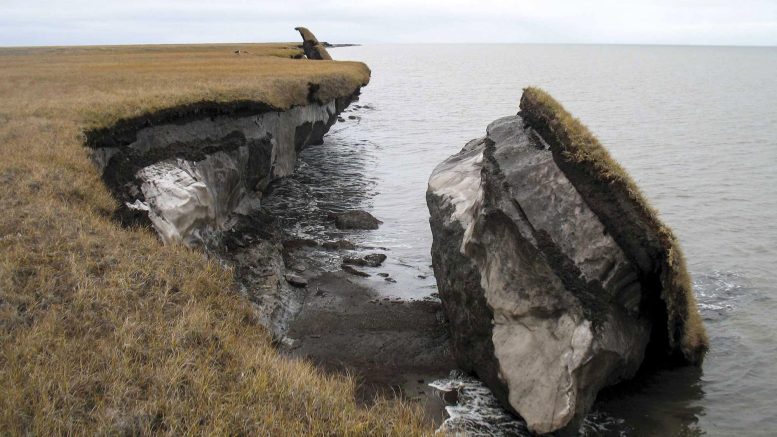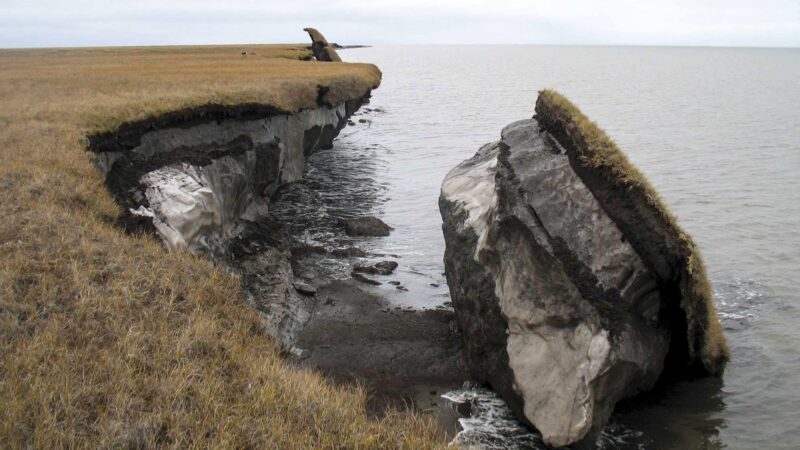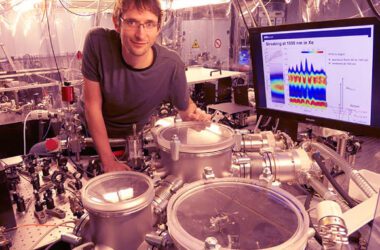
Le dégel du pergélisol peut entraîner la perte de terrain, comme le montre cette image où une partie de la falaise côtière de Drew Point, en Alaska, s’est effondrée dans l’océan. Crédit : Benjamin Jones, USGS
Les scientifiques se tournent vers une combinaison de données recueillies dans l’air, sur terre et dans l’espace pour obtenir une image plus complète de la façon dont le changement climatique affecte les régions gelées de la planète.
Le pergélisol de la Terre – un sol qui reste gelé pendant au moins deux ans – renferme des quantités incalculables de gaz à effet de serre, de microbes et de produits chimiques, dont le pesticide DDT, aujourd’hui interdit. Avec le réchauffement de la planète, le pergélisol dégèle de plus en plus vite et les scientifiques sont confrontés à de nombreuses incertitudes lorsqu’ils tentent de déterminer les effets potentiels de ce dégel.
Un article publié plus tôt cette année dans le journal Nature Reviews Earth & ; Environment a examiné l’état actuel de la recherche sur le permafrost. En plus de souligner les conclusions sur le dégel du pergélisol, l’article se concentre sur la manière dont les chercheurs tentent de répondre aux questions qui l’entourent.
Les infrastructures sont déjà touchées : Le dégel du pergélisol a entraîné la formation de gouffres géants, l’effondrement de poteaux téléphoniques, l’endommagement de routes et de pistes d’atterrissage et le renversement d’arbres. Il est plus difficile de voir ce qui a été piégé dans le mélange de sol, de glace et de matière organique morte du pergélisol. La recherche a examiné comment des produits chimiques comme le DDT et des microbes – dont certains ont été gelés pendant des milliers, voire des millions d’années – pourraient être libérés par le dégel du pergélisol.
Ensuite, il y a l’effet du dégel du pergélisol sur le carbone de la planète : Le pergélisol de l’Arctique renferme à lui seul environ 1 700 milliards de tonnes métriques de carbone, dont du méthane et du dioxyde de carbone. C’est à peu près 51 fois la quantité de carbone que le monde a libéré sous forme d’émissions de combustibles fossiles en 2019. La matière végétale gelée dans le pergélisol ne se décompose pas, mais lorsque le pergélisol dégèle, les microbes présents dans la matière végétale morte commencent à décomposer la matière, libérant du carbone dans l’atmosphère.
“Les modèles actuels prévoient que nous verrons une impulsion de carbone libérée du pergélisol vers l’atmosphère au cours des cent prochaines années, potentiellement plus tôt”, a déclaré Kimberley Miner, chercheuse en climatologie à ;” data-gt-translate-attributes=”[{” attribute=””>NASA’s Jet Propulsion Laboratory in Southern California and lead author of the paper. But key details – such as the quantity, specific source, and duration of the carbon release – remain unclear.
The worst-case scenario is if all the carbon dioxide and methane were released within a very short time, like a couple of years. Another scenario involves the gradual release of carbon. With more information, scientists hope to better understand the likelihood of either scenario.
While the review paper found that Earth’s polar regions are warming the fastest, it was less conclusive on how increased carbon emissions could drive drier or wetter conditions in the Arctic. What is more certain is that changes in the Arctic and Antarctic will cascade to lower latitudes. Earth’s polar regions help stabilize the planet’s climate. They help drive the transfer of heat from the equator toward higher latitudes, resulting in atmospheric circulation that powers the jet stream and other currents. A warmer, permafrost-free Arctic could have untold consequences for Earth’s weather and climate.
An Integrated Approach
To understand the effects of the thaw scientists are increasingly turning to integrated Earth observations from the ground, the air, and space – techniques outlined in the paper. Each approach has its advantages and disadvantages.
Ground measurements, for example, provide precise monitoring of changes in a localized area, while airborne and space-based measurements can cover vast areas. Ground and airborne measurements focus on the specific time they were collected, whereas satellites constantly monitor Earth – although they can be limited by things such as cloud cover, the time of day, or the eventual end of a satellite mission.
The hope is that using measurements from a combination of platforms will help scientists create a fuller picture of changes at the poles, where permafrost is thawing the fastest.
Miner is working with colleagues on the ground to characterize the microbes frozen in permafrost, while others are using airborne instruments to measure emissions of greenhouse gases such as methane. In addition, airborne and satellite missions can help to pinpoint emissions hotspots in permafrost regions.
There are also satellite missions in the pipeline that will provide carbon emissions data with greater resolution. The ESA (European Space Agency) Copernicus Hyperspectral Imaging Mission will map changes in land cover and help monitor soil properties and water quality. NASA’s Surface Biology and Geology (SBG) mission will also use satellite-based imaging spectroscopy to collect data on research areas including plants and their health; changes to the land related to events like landslides and volcanic eruptions; and snow and ice accumulation, melt, and brightness (which is related to how much heat is reflected back into space).
SBG is the focus area of one of several future Earth science missions that make up NASA’s Earth System Observatory. Together, these satellites will provide a 3D, holistic view of Earth, from its surface through the atmosphere. They will provide information on subjects including climate change, natural hazards, extreme storms, water availability, and agriculture.
“Everyone is racing as fast as they can to understand what’s going on at the poles,” said Miner. “The more we understand, the better prepared we will be for the future.”
Reference: “Permafrost carbon emissions in a changing Arctic” by Kimberley R. Miner, Merritt R. Turetsky, Edward Malina, Annett Bartsch, Johanna Tamminen, A. David McGuire, Andreas Fix, Colm Sweeney, Clayton D. Elder and Charles E. Miller, 11 January 2022, Nature Reviews Earth & Environment.
DOI: 10.1038/s43017-021-00230-3



